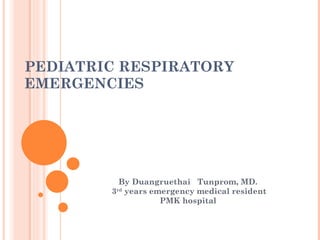
Pediatric respiratory emergency : lower
- 1. PEDIATRIC RESPIRATORY EMERGENCIES By Duangruethai Tunprom, MD. 3 rd years emergency medical resident PMK hospital
- 4. MANAGEMENT APPROACH BASED ON CONTROL ADULTS AND CHILDREN OLDER THAN 5 YEARS
- 6. ESTIMATED EQUIPMENT DAILY DOSES OF INHALED GLUCOCORTICOSTEROIDS FOR ADULTS AND CHILDREN OLDER THAN 5 YEARS
- 8. SEVERITY OF ASTHMA EXACERBATIONS 1
- 9. SEVERITY OF ASTHMA EXACERBATIONS 2
- 10. SEVERITY OF ASTHMA EXACERBATIONS 3
- 11. DIFFERENTIAL DIAGNOSIS OF ASTHMA Condition Distinguishing characteristics Infection Anatomic /Congenital Acquired
- 15. ED MANAGEMENT OF ACUTE ASTHMA
- 24. RECOMMENED DOSES OF MEDICATIONS FOR ACUTE ASTHMA(CONT.) Drug Dose L-epinephrine (1:1000) or terbutaline (1.0 mg/mg) 0.01ml/kg/dose SC or IM (max 0.4 ml) May be repeated every 10-15 min IV terbutaline 10 µg/kg bolus over 10 min,then 0.1-0.3 µg/kg/min infusion Every 30 min,may increase infusion by 0.3 µg/kg/min to a max of 5 µg/kg/min Prednisolone 2 mg/kg (max 60mg), in ED 1 mg/kg/dose bid, home therapy Dexamethasone 0.6mg/kg PO, 2 dose 24 hrs apart IV methylprednisolone 1-2 mg/kg (max 125 mg) IV magnesium sulfate 50-75 mg/kg over 20 min(max 2.5g)
- 27. BRONCHIOLITIS
- 29. Increased mucus secretion, cell death, and sloughing, a peribronchiolar lymphocytic infiltrate and submucosal edema Combination of debris&edema produces critical narrowing & obstruction of small airways .
- 31. SUGGEST BRONCHIOLITIS ASSESSMENT TOOL Mild Moderate Severe Feeding Normal Less Poor SaO2 in room air ≥ 95 % 92 -94 % < 92 % Respiratory rate(/min) < 60 60 - 70 > 70 Retraction None/ minimal Intercostal Substernal Accessory muscle use None None Neck or abdominal Wheeze None/minimal Moderate expiratory Severe inspiratory/expiratory, audible without stethoscope Air exchange Good, equal breath sound Localized decrease breath sound Multiple area of decrease breath sound
- 32. ED MANAGEMENT OF BRONCHIOLITIS Improved Not Improved Improved Not Improved
- 41. HTTP://EMEDICINE.MEDSCAPE.COM/ARTICLE/800428-TREATMENT PEDIATRIC BRONCHIOLITIS: DIFFERENTIAL DIAGNOSES & WORKUP AUTHOR: MARK LOUDEN, MD, FACEP, ASSISTANT MEDICAL DIRECTOR, EMERGENCY DEPARTMENT, DUKE RALEIGH HOSPITAL CONTRIBUTOR INFORMATION AND DISCLOSURES UPDATED: DEC 27, 2010
Notas del editor
- Pulsus paradoxus ในการหายใจปกติ พบว่า เมื่อมีการหายใจเข้า systolic blood pressure สามารถลดได้ประมาณ 10 mm.Hg pulsus paradoxus เกิดขึ้นเมื่อมีความแตกต่างของ systolic blood pressure มากกว่า 12 mm.Hg ระหว่างการหายใจเข้า pulsus paradoxus สามารถเกิดขึ้นในผู้ป่วย COPD, severe asthma, pericardial tamponade, aortic insufficiency นอกจากนี้ poor LV compliance สามารถเกิด pulsus paradoxus โดยไม่มี pericardial fluid เพื่อต้องการวัด paradoxical pulse ผู้ป่วยควรนอน อยู่ในท่าสบาย ศีรษะ อยู่ประมาณ 30 ถึง 45 ( ซึ่งอาจทำได้ยากในผู้ป่วย COPD, severe asthma หรือ cardiac tamponade) เริ่มต้นการวัด โดย การ inflate cuff ขึ้นไปจนไม่ได้ยินเสียงอะไร จากนั้น deflate cuff จนกระทั่งได้ยินเสียงชีพจรเสียงแรก โดยที่เสียงนี้ จะ มีความสอดคล้องกับการหายใจออก ( คือได้ยินเมื่อหายใจออก และ หายไปเมื่อหายใจเข้า ซึ่งหมายความว่าเป็น systolic blood pressure ในช่วงหายใจออก จากนั้นให้ deflate cuff จนกระทั่งได้ยินเสียงชีพจรตลอด ( ทั้งตอนหายใจเข้าและหายใจออก ซึ่งหมายความว่าเป็น systolic blood pressure ในช่วงหายใจเข้า ) ด้วยวิธีการเช่นนี้ ทำให้เราสามารถตรวจพบ pulsus paradoxus ได้ถ้า ความแตกต่างมีมากพอ ถ้าความแตกต่างของ systolic blood pressure ระหว่างหายใจเข้าและหายใจออกมากกว่า 12 mm.Hg แสดงว่า paradoxical pulse สูง ผู้ป่วยส่วนใหญ่ที่มี tamponade มักมี paradoxical pulse มากกว่า 20-30 mm.Hg ระหว่างการหายใจ ซึ่งอาจมีข้อยกเว้นในผู้ป่วยที่มี pulse pressure แคบมากๆ เช่นในผู้ป่วยที่มี advanced tamponade ที่อาจวัด paradoxical pulse ได้เป็นเท็จลวง คือประมาณ 5-15 mm.Hg เนื่องจาก systolic blood pressure อาจจะต่ำกว่า diastolic blood pressure ด้วยเหตุผลนี้ อัตราส่วนระหว่าง paradoxical pulse ต่อ pulse pressure จึงเป็นดัชนี ที่เชื่อถือได้มากกว่า paradoxical pulse โดยถือว่าเมื่อมากกว่า 50% ผิดปกติ Pulsus paradoxus มีความสัมพันธ์กับ cardiac output ที่ลดลงเนื่องจาก tamponade ใน pericardial effusion, pulsus paradoxus ที่มากกว่า 25 mm.Hg ทั้ง sensitive และ specific ต่อ severe มากกว่า mild tamponade ในผู้ป่วยเด็ก pulsus paradoxus ถูกศึกษาเพื่อทำนายความรุนแรงในโรคปอด เช่น ในโรคหอหหืด พบว่า ถ้าผู้ป่วยมี pulsus paradoxus มากกว่า 15 mm.Hg จะมีอาการของโรคที่รุนแรงกว่า ถึงแม้ว่าจะมีโรคหลายชนิด ที่อาจระบุได้จากการตรวจ pulsus paradoxus แต่มักจะเป็นการยากโดยการวินิจฉัย pulsus paradoxus โดยใช้แต่ sphygmomanometer เพียงอย่างเดียว ในการศึกษาของ Jay และ คณะพบว่า แพทย์เวชศาสตร์ฉุกเฉินและแพทย์เวชศาสตร์วิกฤต ไม่สามารถวัด pulsus paradoxus ได้อย่างแม่นยำ โดยการใช้ sphygmomanometer ดังนั้นจึงควรมีการพัฒนาเครื่องมืออื่นๆ ที่สามารถช่วยวินิจฉัย pulsus paradoxus
- Infection of bronchiolar respiratory and ciliated epithelial cells produces increased mucus secretion, cell death, and sloughing, followed by a peribronchiolar lymphocytic infiltrate and submucosal edema. The combination of debris and edema produces critical narrowing and obstruction of small airways.
